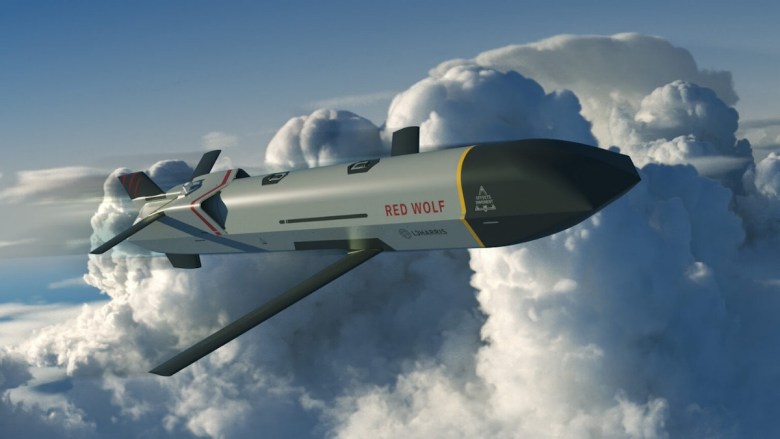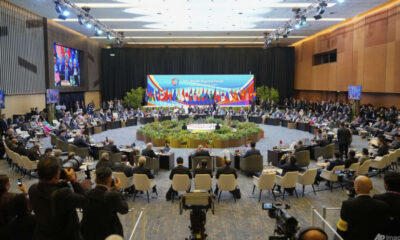Top Stories
US Unveils Affordable Missiles to Compete with China’s Military Might

The United States is advancing its military strategy by introducing a new generation of affordable cruise missiles aimed at countering China’s growing military capabilities. L3Harris Technologies announced the development of the “Red Wolf” and “Green Wolf” missiles, which are designed to provide long-range strike options for the U.S. military. This initiative comes amid rising tensions in the Pacific region and reflects the U.S. Department of Defense’s (DoD) push for an “affordable mass” strategy in response to recent global conflicts.
Both the Red Wolf and Green Wolf missiles exceed a range of 200 nautical miles and are capable of targeting moving naval vessels. The Red Wolf is tailored for precision strikes, while the Green Wolf focuses on electronic warfare and intelligence gathering. Production is currently taking place in Ashburn, Virginia, with L3Harris expecting to manufacture approximately 1,000 units annually at a projected cost of around US$300,000 each. Following over 40 successful test flights, these systems represent a strategic shift in missile development, challenging the dominance of established players like Lockheed Martin and RTX in the long-range missile sector.
Market Landscape and Strategic Implications
The introduction of the Red and Green Wolf missiles aligns with a broader trend towards affordable weaponry, joining other systems like Anduril’s Barracuda and Lockheed Martin’s Common Multi-Mission Truck (CMMT). These weapons aim to saturate potential adversaries with mass-produced munitions. The Barracuda, available in three configurations, highlights rapid production using commercial components and modular capabilities, while Lockheed Martin’s CMMT focuses on price and global assembly for large-scale deployment.
As the U.S. military shifts towards these cost-effective options, a pressing question arises: can these lower-cost missiles provide the necessary firepower and operational effectiveness against a technologically advanced adversary like China? According to the 2024 China Military Power Report, China possesses the world’s largest navy, with over 370 ships and submarines, including more than 140 major surface combatants.
Experts like Mark Gunzinger have noted that the U.S. is facing a shortage of precision-guided munitions (PGMs), a situation exacerbated by outdated military planning that has historically favored short engagements. This shortage raises concerns about the U.S. military’s ability to sustain operations in a prolonged conflict, particularly in scenarios like a potential confrontation over Taiwan.
In a January 2023 report, Seth Jones from the Center for Strategic and International Studies (CSIS) warned that the U.S. defense industrial base is not adequately prepared for prolonged conflict, lacking resilient supply chains. He emphasized that in a Taiwan crisis, the U.S. could deplete its stockpile of high-end munitions, such as the Long-Range Anti-Ship Missile (LRASM) and the Tomahawk cruise missile, very quickly.
Balancing Cost and Capability
While increasing production of affordable PGMs may alleviate some shortages, experts caution that these weapons often lack the advanced capabilities—like stealth and range—necessary for impactful military operations. Recent analyses indicate that while Israel effectively neutralized drone threats using lower-cost munitions, Ukraine’s reliance on high-end missiles has proven more disruptive against Russian forces.
The disparity in performance between high-end and low-cost systems poses a significant challenge. The U.S. must consider a high-low mix of munitions to effectively deter China, according to Stacey Pettyjohn and others. They argue that while high-end weapons are crucial for specific missions, their limitations in cost and availability could hinder U.S. response capabilities in a high-stakes conflict.
To address these challenges, analysts have highlighted the need for reforms in the U.S. acquisition process and production infrastructure. A report by Shands Pickett and Zach Beecher pointed out the growing divide between traditional defense contractors and innovative tech firms, which complicates efforts to integrate new technologies into existing military frameworks.
In summary, while the introduction of affordable missiles like the Red and Green Wolf represents a strategic effort by the U.S. to enhance its military capabilities against China, their effectiveness will depend on successful integration into a cohesive operational strategy. Without significant reforms, the goal of achieving effective deterrence in a potential high-intensity conflict remains uncertain.
-

 Business5 months ago
Business5 months agoKenvue Dismisses CEO Thibaut Mongon as Strategic Review Advances
-

 Lifestyle4 months ago
Lifestyle4 months agoHumanism Camp Engages 250 Youths in Summer Fest 2025
-

 Sports4 months ago
Sports4 months agoDe Minaur Triumphs at Washington Open After Thrilling Comeback
-

 Sports5 months ago
Sports5 months agoTupou and Daugunu Join First Nations Squad for Lions Clash
-

 Top Stories5 months ago
Top Stories5 months agoColombian Senator Miguel Uribe Shows Signs of Recovery After Attack
-

 World5 months ago
World5 months agoASEAN Gears Up for Historic Joint Meeting of Foreign and Economic Ministers
-

 Health4 months ago
Health4 months agoNew Study Challenges Assumptions About Aging and Inflammation
-

 Business5 months ago
Business5 months agoOil Prices Surge Following New EU Sanctions on Russia
-

 Entertainment4 months ago
Entertainment4 months agoDetaşe-Sabah Violin Ensemble Captivates at Gabala Music Festival
-

 Entertainment4 months ago
Entertainment4 months agoBaku Metro Extends Hours for Justin Timberlake Concert
-

 Top Stories5 months ago
Top Stories5 months agoRethinking Singapore’s F&B Regulations Amid Business Closures
-

 Business5 months ago
Business5 months agoU.S. House Approves Stablecoin Bill, Sends to Trump for Signature









